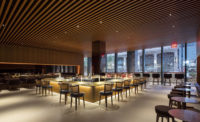In New York City, where restaurants last an average of two years and seldom more than seven, a dining establishment that survives for half a century might seem a culinary Methuselah. However, the 2009 Zagat guide lists no fewer than 75 Gotham restaurants at least 50 years old, a roster to which must now be added the Four Seasons, which opened on July 20, 1959, on the ground floor of Ludwig Mies van der Rohe and Philip Johnson’s Seagram Building. Two hundred seasons later, this visionary fusion of high-style American design and haute American cuisine offers another object lesson: As our civic realm is increasingly compromised by commercialism, the enduringly elevated tone of the The Four Seasons makes it a loftier enterprise than some cultural institutions.
Unrelated to the eponymous hotel chain founded in 1961, The Four Seasons recast luxury dining in an entirely new scenario, with contemporary design given the starring role. Though usually ascribed to Johnson alone, this complex project was actually a collaboration among several of Midcentury Modernism’s brightest lights: interior decorator William Pahlmann, a follower of Jean-Michel Frank, who made a Minimalist water feature the epicenter of the restaurant’s jaw-dropping Pool Room; industrial designer L. Garth Huxtable (husband of Ada Louise, pioneering New York Times architecture critic), whose suavely modeled table settings feature what I consider the Martini glass of the century; plus landscape architect Karl Linn and horticulturist Everett Lawson Conklin, whose wow-inducing plantings underscored the restaurant’s seasonal conceit.
Also involved were Richard Kelly, Johnson’s longtime mood-lighting specialist; textile designer Marie Nichols, who had done innovative auto upholstery for the short-lived Kaiser-Frazer Corporation; and two groovy young graphic designers — Elaine Lustig Cohen, who devised the building’s crisp signage, and Emil Antonucci, who created the restaurant’s enchanting logo, a quartet of sprightly stylized trees. And hovering above them all was the godlike Mies himself, whose classic chrome-framed Brno chair was reissued as dining-room seating.
The Four Seasons’ fine art program was commensurately ambitious. Alfred H. Barr, Jr., the Museum of Modern Art’s legendary founding director, persuaded his old friend Pablo Picasso to sell the fore-curtain he created for Sergei Diaghilev’s 1919 ballet The Three-Cornered Hat. That monumental masterwork, acquired for $75,000, still ennobles the long, narrow corridor linking the main dining rooms.
The sculptor Richard Lippold, then at the height of his renown, made two ceiling-hung pieces. A rising art star, Mark Rothko, agreed to paint a series of brooding, color-saturated abstractions. But in a fit of class-conscious paranoia after dining at the restaurant, Rothko balked, refunded his fee, and the majority of his 30 Seagram Murals are now in London’s Tate Modern.
However, the true auteur of The Four Seasons was Johnson, who coordinated its manifold components so deftly that the result seems the work of a single hand. He demonstrated as never before how Modern architecture, interiors, and art could be marshaled to transform a quotidian activity into a social event that renders a commercial context irrelevant. This was one of Johnson’s very few indisputably first-rate works, and its status as the finest International Style public interior in America was a consensus well before the restaurant became a New York City landmark in 1988, the first Modernist decorative ensemble to be so honored.
Beyond protection under municipal statute, The Four Seasons has made it to 50 because of its gradual evolution into a New York social institution of seminal significance. For generations, the city’s WASP and Jewish elites had entertained at exclusionary private clubs and deemed public restaurants the province of parvenus. But by the third quarter of the 20th century, that old order had passed and New York’s ascendant media-oriented meritocracy needed a new kind of gathering place, more inclusive and better suited to the seismic changes wrought by the 1960s.




